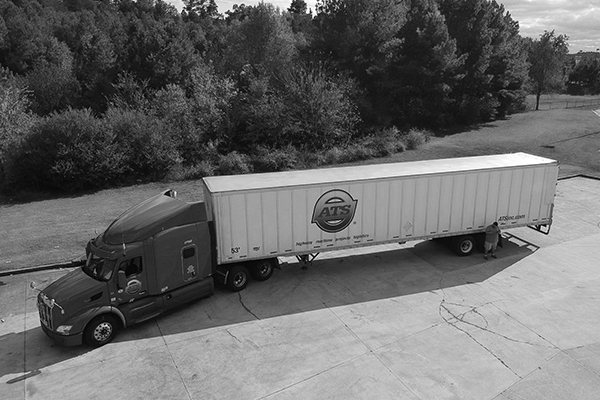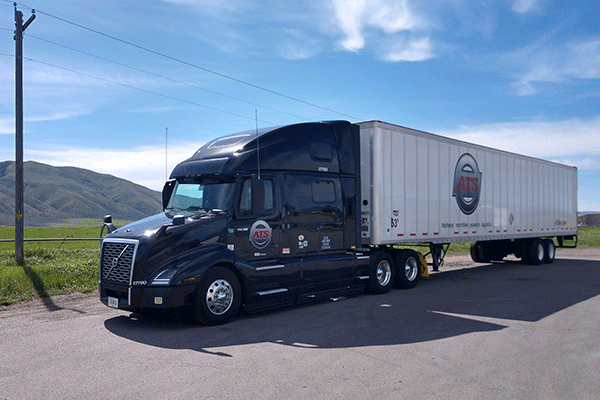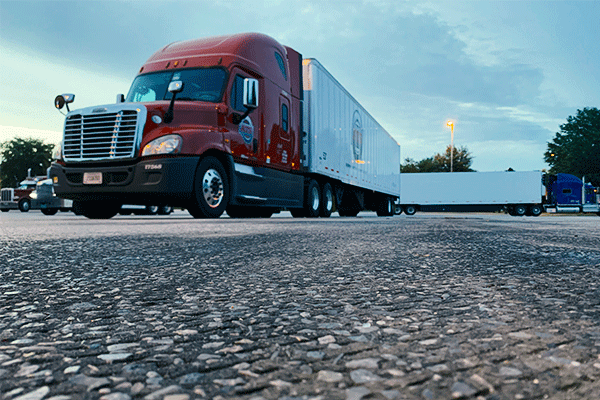
With so many options for moving smaller quantities of freight, it’s understandable why making these decisions leaves shippers feeling overwhelmed. There’s nothing wrong with a bit of hesitancy when interacting with the transportation world. In fact, we’d say it’s a good thing.
Here at ATS, we understand the position our industry has put shippers, like you, in. Over the years, the pace at which the transportation industry moves has only increased.
And, without a transportation expert on your side, what hope does your company have of keeping up?
Knowing which service will fit your needs and pinpointing those that aren’t a good fit isn’t easy. In today’s article, though, we’ll aim to make it a bit more cut and dry.
One of the most essential offerings trucking companies and freight brokerages have to offer is partial-truckload shipping. For many supply chains, PTL freight transportation fits like a glove, opening doors to long-term partnerships and cost savings.
That said, it’s not the right solution for all businesses. Is it a good option for yours?
To keep you from making the wrong decision for your cargo’s transport— a decision that could damage your reputation and bottom line — it’s important that you understand all of your options.
And partial truckload freight shipping is certainly one of them.
Below, we’ll give you comprehensive answers to the following questions:
- What is partial-truckload shipping?
- What are the advantages of partial-truckload shipping?
- What are the disadvantages of partial-truckload shipping?
In the end, this article will give you a far firmer grasp on this potentially useful transportation service as well as the tools you need to make the most educated decision for your company. Let’s get into it.
What is Partial-Truckload Shipping?
Partial-truckload (PTL) shipping is the process of moving mid-sized quantities of freight that simply don’t require the full capacity of a semi-trailer. While specifications vary, PTL loads are tiered above less-than-truckload (LTL) and below full-truckload (FTL) shipments in terms of trailer space needed and, often, pricing.
Where dimensions are concerned, partial-truckload (PTL) shipments typically fall into the following buckets:
| Total Cargo Weight | Total Cargo Length | Total Pallet Count |
| 5,000-30,000 pounds | 8-30 feet | 5-15 pallets |
For shippers with cargo dimensions that match these ranges, partial-truckload shipping provides a relatively cost and time-efficient transportation option.
And, even though the transit timing instability of PTL shipping makes it prohibitive in some situations, nearly every industry utilizes these capacities to move its products. From dry van capacities to flatbed, step-deck and other open-deck trailers, if you have a product to move, you can likely do so in partial-truckload portions.
What Are The Advantages of Partial-Truckload Shipping?
Just like anything else in the transportation world, partial-truckload transportation has its own set of pros and cons. Whether they motivate you toward or away from this service depends entirely on your business’s goals, timelines and procedures.
To give you the most well-rounded overview of partial-truckload shipping, let’s discuss the advantages of routing your freight in this manner, which are:
- You don’t have to worry about your freight class with PTL.
- PTL shipping helps you avoid (LTL) accessorial charges.
- There’s less risk of cargo damage with PTL services.
- PTL transit times are quicker than LTL services.
- Partial-truckload shipping can be less expensive than FTL Shipping.
1. You Don’t Have to Worry About Your Freight Class
Freight class is an instrumental piece of less-than-truckload transportation pricing and services. The density, stow-ability, ease of handling and liability potential — which together identify freight classification — of each shipment, factor heavily into its final LTL shipping rate.
Since less-than-truckload quantities are smaller than that of PTL and FTL, their classification codes do an apt job of dictating the price of moving them.
This isn’t the case with partial-truckload services.
In fact, shipping 12 pallets of a class 400 product — one of the most expensive freight classes — LTL would be extremely costly. Shipping that same cargo PTL would be priced more appropriately as partial truckload commodities are quoted based on the total amount of trailer space needed instead of freight classification.
As a result, shippers find it more cost-effective to ship a larger quantity of freight using partial-truckload services over multiple LTL loads.
2. You Avoid Less-Than-Truckload (LTL) Accessorial Charges
Moving freight of any quantity or size comes with a mix of potential accessorial add-ons and price hikes. That said, the less-than-truckload shipping market feels like it boasts more than the field — probably because it does.
There is a catalog of additional fees that come into play exclusively for LTL shipments. Each of these charges, when applied, marks the bottom lines of LTL shippers and, without transparent communication from their transportation provider, can quickly add up.
With partial truckload shipping, accessorials like re-weight and re-class charges can be avoided as they simply don’t apply. For this reason, planning out a budget is easier with PTL transportation.
3. Less Risk of Damage Compared to LTL
Less-than-truckload transport, similar to partial shipping, is often a terminal-based procedure. Each load is taken from facility to facility and shifted to either make room for more freight or to change trailers entirely.
With every one of these touchpoints, the potential for damage to an LTL product increases as the hustle and bustle of workers may lead to mishandling in some instances.
Sending a larger quantity of your goods PTL, however, can help you avoid many of these issues. Commonly, freight that’s hauled PTL isn’t transferred from one trailer to the next and, if carriers plan out their trailer space efficiently, once your product is secured it won’t move until it arrives.
As a result, expect to experience fewer cargo claims and freight damage with PTL than with other transportation methods.
4. Quicker Transit Times Than Shipping LTL
One of the main drawbacks of less-than-truckload shipping is the lengthy transit times that can accompany it. Unless they use expedited services, shippers often find it difficult to meet deadlines when moving freight LTL.
Although PTL shipping still presents an issue where transit timing is concerned — compared to dedicated services — this discrepancy is less drastic.
With PTL your truck will need to make multiple pick-ups and deliveries — which can make predicting arrival times difficult — but your load won’t need to change trailers once situated. As such, expect a more expedited delivery timeframe than LTL services can offer.
5. Cheaper Than Full-Truckload (FTL) Shipping
With dedicated services like full-truckload shipping you’ll be purchasing a trucker’s time and entire trailer space.
Even though doing so only becomes feasible in times of extreme urgency or should your load exceed PTL dimensional capacities, full-truckload shipping will be more expensive than partial services.
For this reason, PTL transportation can be a cost-effective option for shippers that only need limited trailer space and are flexible with their pick-up and delivery timelines.

What Are The Disadvantages of Partial Truckload Shipping?
Now that you understand the five largest advantages of utilizing partial-truckload transportation services, let’s discuss the other side of the coin. Sure, PTL presents a competent option for many shippers in a variety of industries, but it’s not all good.
In fact, in several instances shipping freight PTL won’t fit your needs.
The four largest disadvantages of shipping freight using PTL services are:
- Longer transit times than FTL shipping.
- More expensive than LTL shipping.
- Specifying correct dimensions and quantities is crucial.
- You need more leniency on deadlines than with FTL.
1. Longer Transit Times Than FTL Shipping
Full-truckload shipping makes it easy to predict transit times. You’ve paid for a dedicated service. That trucker is, essentially, an extension of your business until your freight is dropped at the feet of your consignee.
This makes planning out delivery schedules and matching your capabilities to the commitments you’ve made, easier. The transit timing on partial-truckload freight doesn’t come with the same predictability.
Instead of leaving your facility and heading directly toward your receiver’s door, a PTL shipment has some additional stops to make. Whether these pause points are at another pick-up location or for a delivery, you’re not the only company using that carrier’s trailer space.
For this reason, it’s important that you’re realistic on the transit timing of your load when utilizing PTL services. Expedited transit times — like those offered by FTL services — come at a price, a price you’re not paying with partial truckload transportation.
2. More Expensive Than LTL Shipping
Since you’re sending larger quantities of freight, tying up a larger portion of each trucker’s hours of service (HOS) clock and trailer, PTL shipping will be more expensive than LTL.
The convenience of having a partially-dedicated truck, trailer and driver comes at an elevated cost when compared to smaller-quantity services. Fewer people are chipping in to pay for that trucker’s services — which is the only way he makes money.
As such, make sure to budget for this uptick in pricing — especially if you commonly send freight the less-than-truckload way.
3. Specifying Direct Dimensions Is Critical
Sometimes things go awry with partial truckloads without proper front-end communication. You see, for trucking companies to offer this service, they need to know exactly what each shipper needs to move.
Truck drivers only have so much trailer space. And to dole it out appropriately takes a good bit of planning on their behalf. This is why issues crop up. Without knowing the correct dimensions (weight, length, width and height) of each company’s shipment, issues can occur when a trucker arrives un-prepared.
If your truck shows up without the correct trailer type and the amount of space you need, your load won’t be getting moved. Unfortunately, though, this happens all too often in PTL transportation.
As such, prioritizing clear communication and comprehensively expressing your needs to your carrier is important should you decide PTL shipping is right for you.
4. Need More Leniency on Deadlines Than With FTL
The fourth and final issue you’ll find with PTL shipping is that pick-up and drop-off times usually can’t be set in stone. Especially not the same way that full-truckload shipments allow for.
PTL carriers have other commitments to meet. As a result, your deadlines may be put on the back-burner in exchange for those of another company. So, if you have strict pick-up and/or drop-off appointments that need to be met, don’t expect PTL services to meet them.
Instead, you’ll find better luck by adding a bit of leniency to your processes and working with consignees to manage expectations on their end.
Is Partial-Truckload Shipping Right For Your Business?
As a business in an increasingly fast-paced marketplace, your continual desire to optimize is understandable. Partial-truckload shipping might be an excellent method for doing just that.
Now you understand what this service brings to the table. Where it falls short and how it excels. That, when done correctly, PTL freight transport can help you take your shipping budget further than other methods. And, how intricate this process can be.
Here at ATS, we take pride in helping shippers, like you, get the most from their supply chains and their shipping budgets.
To do so, our Learning Hub is updated multiple times every week with excellent pieces of educational content, we invite you to check it out.
Concerning other transportation service offerings here are some additional articles that you may find helpful going forward:
- How to Ship Less-Than-Truckload (LTL) Freight: A Step-By-Step Guide
- Why is my freight shipment taking so long? [LTL, PTL & FTL comparison]
- What is “Zone-Skipping” in Freight Shipping
Finally, should you have any questions about how ATS can help you add partial-truckload shipping to your business’s supply chain, contact us today. We’re happy to show you how customer needs come first, the ATS way.





